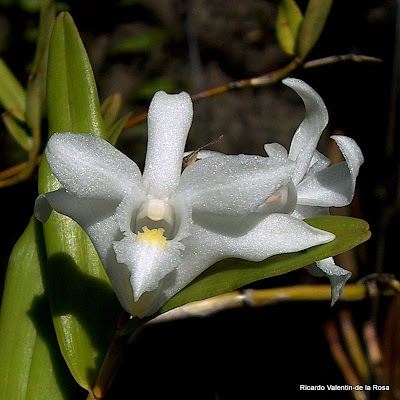Dendrobium crumenatum,
known as the pigeon orchid, is ubiquitous in orchid collections in the island
of Puerto Rico. I suspect the two main
the reasons it is so common in collections are, one, it can grow well under
Puerto Rico’s climatic conditions and two, it is generous producing plantlets
along its flowering stems. Also, it can
stand utter neglect and can survive a wide range of light exposures from full
sunlight to deep shade.
The flowers of Den.
crumenatum last only one day, but this is compensated by the fact that the
plant blooms every time there is a strong shower that lowers the temperature 10
degrees Fahrenheit. The flowers are
strongly fragrant and a big plant can have dozens of flowers at the same
time. As a result of this orchid
capacity to survive, and even thrive, with minimal or no care, many people
simply tie a plant to a tree and essentially forget about it. If the location is favorable Den. crumenatum can grow into a huge
plant with many canes.
In 1984, I visited the garden of Dr. Juan A. Rivero, he had
many types of orchids, growing both on trees and in pots. I noted that there was a seedling Den. crumenatum in the trunk of a
tree. Dr. Rivero told me that the plants
would set seed and that some plantlets had appeared spontaneously on the
trees. The next time I saw seedlings growing
feral was in January 2012. In January
2012, I visited the city of San Sebastian to participate in the Festival de la
Novilla. This festival is named because
a young cow is adorned with ribbons and paraded through the streets of the city. Needless to say lots of drinking and
merrymaking happens, but I digress. As I was walking along a city street I saw
a large plant full of blooms inside a fenced garden. I
stopped to take some photos and then I noticed that in one of the trees that
lined the street there were seedlings of this Dendrobium.
The seedlings were growing on the trunk, from a little bit
below eye level to high in the branches.
It counted a dozen seedlings on the tree. Some were close to blooming size and others
were only a few inches long. The tree
where the seedlings were growing was about twenty feet away from the site of
the specimen plant, which I suspect was the parent.
As I explored the area, I noticed there were a number of
orchids on the nearby trees, with the exception of the tree with the seedlings,
all were in the gardens and clearly put there by humans. There
was a large plant of Dendrobium
cucullatum, a clump of Dendrobium
Jacqueline type, a strap leaf Vanda and many Arachnis plants, probably from their look Arach. Maggie Oei.
Given that the seedlings of Den. crumenatum are becoming established with no human help, and
that locals clearly love to see orchids on their trees, I would think it will
stand little difficulty colonizing the area.
I checked other trees near the one with seedlings but no other had
seedlings on them. Maybe next year, as I
go to the Festival de la Novilla, I will go and see how they are doing.
If you notice any
exotic orchid growing in the wild in Puerto Rico, please contact Prof. Ackerman
of the University of Puerto Rico in Rio Piedras. He is studying invasive orchid species and
will appreciate the information. It is
important that the information on the location of the plants be as precise as
possible.


















2 comments:
Hi,
I came across your blog researching Den Anosmum culture. I looked all over your site to see if i could see the description of your Anosmum growing in soda bottles. Can you please direct to it? Your blog is amazing to say the least. Thx a lot.
Here is the link
http://ricardogupi.blogspot.com/2008/10/dendrobium-anosmum-when-cultured-so.html
Post a Comment